Impulse Responses are a fairly new technology available to guitarists that can produce amazing results for your recordings or live performances. Knowing how Impulse Responses work and how you can use them can take your playing in new directions.
In this guide, I’ll go into detail on:
- What Impulse Responses are
- How Impulse Responses are created
- Why Impulse Responses are so useful
- What gear you need to use Impulse Responses
- Best free Impulse Responses
If you’re new to Impulse Responses, here is a basic explanation of what they are:
An Impulse Response (IR for short) is a way you can ‘capture’ the qualities of a guitar amp speaker, microphone, and room and recreate it almost perfectly in the studio or for live performances.
Impulse Responses are different from cabinet simulators and tend to produce more realistic results.
Most professional guitarists would struggle to identify the difference between a recording of a guitar amp and an IR. They’re that good.
You get the best results out of Impulse Responses when you use them during recording. Find out how to connect your guitar to a computer and use it as a guitar amp in this guide. You’ll be able to experiment with IRs after following the advice in that guide.
Why Impulse Responses Are So Useful
The best way to understand what Impulse Responses are and why they’re so useful is with a couple of examples:
Impulse Responses in the Studio
Let’s say you’re recording an album and want the best quality guitar parts possible. You love the sound of your guitar amp, but whenever you try to mic up your speaker cabinet, you’re unhappy with the results.
Instead of hiring a sound engineer to professionally mic up and record your guitar, you simply record your guitar amp signal directly to your computer. Now you can use Impulse Responses to transform your direct signal recording into a professional sounding recording.
Let’s say you want to hear what your amp sounds like recorded through a Marshall 4×12 cabinet and a Shure SM57 microphone. Simply load up the Impulse Response for that speaker and mic and your tone will sound almost identical to an actual recording of that mic and speaker combination.
You can then load up other Impulse Responses to try out different speaker and mic combinations. With a click of a button you can hear your recordings through different types and brands of speakers, or different mics. You can even find IRs for different mic placements and different rooms.
Key lesson: Impulse Responses give you a quick and easy way to access a wide range of speaker and mic combinations to create professional-grade recordings.
Impulse Responses for Live Performances
A big challenge when performing live is getting a high-quality tone to the sound engineer. Depending on the venue, you could end up with a great tone, or a horrible mess. A badly placed mic can turn your great guitar tone into a mush.
Impulse Responses allow you to produce consistently high-quality guitar tones at every venue. The way they work during live performances is that you run your signal through an Impulse Response and send that signal directly to the mixing desk.
For example, you could load an Impulse Response onto a Line 6 Helix and send the output directly to the mixer. You can then run your amp as normal on stage, but a perfect tone would arrive at the mixer without any bleeding of other instruments or issues. Your amp wouldn’t need to be mic’d up and you’ll get far better results.
Or let’s say you want to use your powerful tube amp in a tiny venue. You’re not going to be able to get that cranked tube tone in such a small venue without splitting everyone’s ears, but you can with Impulse Responses. Instead of running your tube amp through your speaker cabinet, you would run it through a load box and pass it through an Impulse Response.
The Impulse Response will take your cranked tube amp signal and create an almost-perfect mic’d speaker tone for the mixer. You end up with a great tube tone without the ear-splitting volume that would normally drown out the rest of the band.
Key lesson: Impulse Responses allow you to send high-quality signals directly to the mixer for consistent results from gig to gig.
How Are Impulse Responses Created
Let’s look into detail on how Impulse Responses are created and how they’re able to create such impressive results.
How Impulse Responses Work
Imagine a Mesa 4×12 cabinet sitting in a studio mic’d in a studio. When you play your guitar through that rig, there are a few things changing the tone along the way.
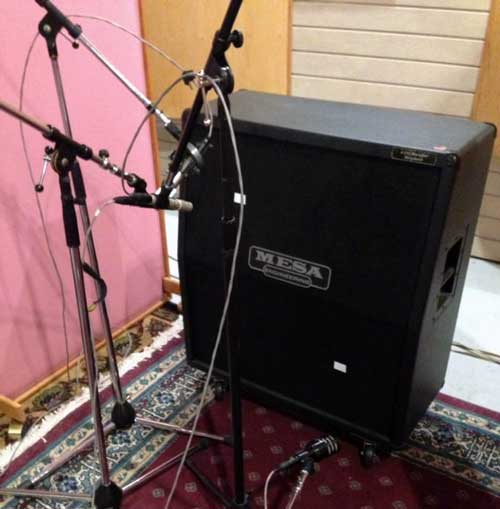
The guitar creates the beginnings of your tone. Any pedals you use will color your tone in different ways. That signal then goes into the guitar amp and the amp will color the signal.
Then the signal arrives in the speaker cabinet. The type of speakers in the cabinet will change your tone. A Mesa 4×12 speaker cabinet will color your tone in a different way compared to an Orange 4×12 or a Marshall 4×12.
The microphone used to record the speaker also colors the tone. A recording with a dynamic microphone will sound different than a recording with a condenser microphone.
The placement of the microphone on the speaker will also color your tone. The distance the mic is from the cabinet and the position of microphone against the speaker all change your recorded tone.
You can even use more than one microphone at the same time and blend the sound between the two.
The room also colors your tone. A studio room with polished wooden floors will sound very different than a carpeted room.
The point to remember here is that your final recording isn’t just a result of your guitar and amp. Everything including the room colors your tone is one way or another.
Impulse Responses allow you to ‘capture’ everything set up after the guitar amp head. The type of speaker you use, the type of mic(s), placement of the mic(s), and type of room can all be captured with Impulse Responses.
Once you capture your speaker and mic setup using Impulse Responses, you can use those IRs in future recordings or performances. Many guitarists build up libraries of different IRs to use for future recordings.
What is an Impulse?
Before Impulse Responses were used to recreate guitar speaker setups, they were often used to ‘capture’ different reverbs. Understanding how Impulse Responses were used with reverb makes it easier to understand how they work with guitar amp speakers.
Clap your hands and listen to the sound. The sound you hear will change depending on the room you’re in.
If you’re in a tiled bathroom, you will hear a strong reverb trail after your clap. If you’re in a small bedroom, the reverb trail might be hard to hear. Clap your hands in a big open space and it will again sound different.
In this example, the clapping of your hands is the impulse. The true sound of your hands clapping doesn’t produce any reverb.
The room colors the sound of your hands clapping. Think of the way the room adds reverb to your clap as the ‘response’.
By taking an impulse and recording it, we can measure the response of that room and equipment. We can then take that Impulse Response and feed other sounds into it and it will recreate the reverb from that room over the new sounds.
With guitar speakers, we can capture the response of a specific type of speaker (eg: Marshall) and feed new sounds into it to color the tone.
What Are Impulse Response Files?
So how do you use Impulse Responses? There are many Impulse Responses available online for free or at a cost. If you try downloading a free Impulse Response, you might be surprised with what you receive.
An Impulse Response file is basically an audio file in wav format. If you try to play the file through an audio player, the audio is so short that you won’t hear anything. But when you load it in an IR loader, you end up with an impressive recreation of the guitar amp speaker and equipment used.
As an example, this is what a typical Impulse Response looks like if you load it in an audio editor:

Not very exciting, right?
Well if you load that IR into an IR Loader (covered later), that simple audio file will allow you to sound as if you were recording through an expensive guitar cabinet and mic in a professional studio.
The audio file gives the IR loader all the information it needs to recreate the sound qualities of a cabinet, mic and room.
Best Free Guitar Impulse Responses
If you want to try some Impulse Responses out to see what all the fuss is about, here are some of the best free options.
Many of the best Impulse Response libraries will cost money, but these free IR libraries may be all that you need.
- God’s Cab by Wilkinson Audio
- Redwirez IR Library
- Kalthallen Cabs
- Allure IR Pack by Line 6
- Free Celestion Impulse Responses
Download the above libraries and follow the advice below to start experimenting with Impulse Responses.
How to Use Impulse Responses
To use Impulse Responses, you need something called an IR loader. There are plenty of options for IR loaders, so let’s look at some of these options.
DAW Plugins
The first type of IR loader is a DAW plugin. There are free and paid IR loaders you can download and install into your DAW for your recordings.
Pulse by Lancaster Audio is a popular free IR loader plugin and is an easy way to start experimenting with Impulse Responses.
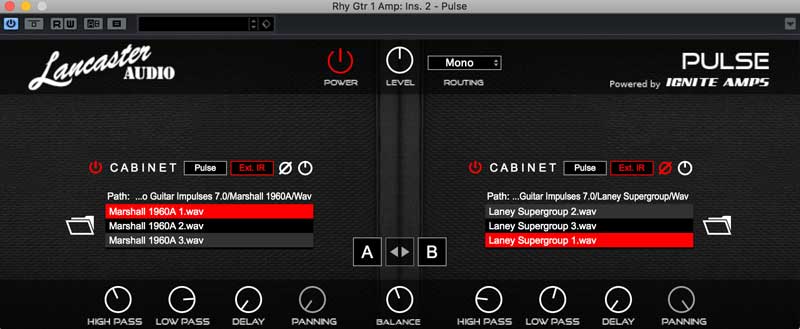
You use an IR loader plugin just like any other plugin. You add it to the guitar tracks and can load any Impulse Response you want.
You can see that the above IR loader lets you easily import IR files, toggle or mix between two different cabinets, and even apply a high or low pass EQ filter.
This is a great option if you’re looking at recording and want to try out different cabinet and mic combinations. Even if you already use a cabinet modelling plugin, I recommend trying out IRs and comparing the results against the modelling plugin.
The big benefit of using a DAW plugin is that it gives you complete consistency across recordings. You don’t need to try and perfectly reposition the mic against your cabinet for each recording. The IR lets you return to the exact same cabinet configuration at any time in the future.
Find out how to connect your guitar to a computer in this guide. Once your guitar is connected and you have the right software, you can start experimenting with IRs.
Impulse Response Guitar Pedals
As IR technology improved, it eventually became possible to have a professional IR loader built into a guitar pedal. This means you can load up your Impulse Responses directly into your rig with a standard guitar pedal.
These pedals are a great way to use IRs for live performances, recordings, or just jamming at home.
MOOER Radar: While there are expensive IR pedals out there, one that’s on the cheaper side is the MOOER Radar:
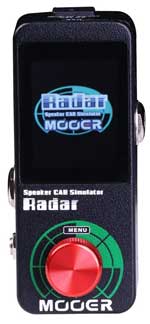
This tiny pedal comes loaded with 30 cabinet models, 11 mic models, and 4 power amp models. That means you can immediately start experimenting with IRs in your rig.
While that’s a great start, it also has the ability to store custom IRs by connecting the pedal to a PC via USB.
Find out more about the MOOER Rader here.
The great thing about this pedal is that it’s relatively cheap and fits in with any pedalboard. Most of the other IR based pedals I found were quite large.
TC Electronic Impulse IR Loader: announced in early 2022, this tiny pedal holds up to 99 Impulse Responses with 25 preloaded from the factory.
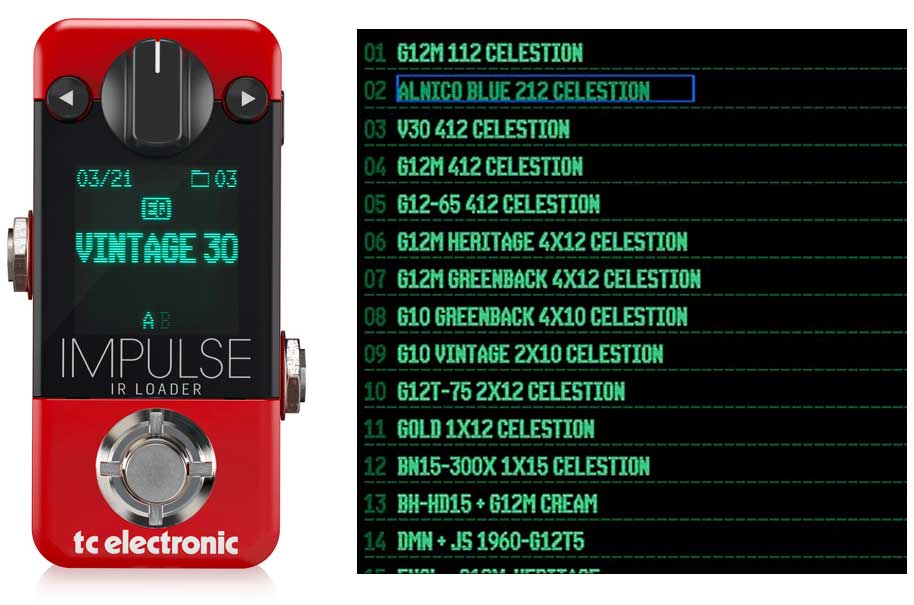
The IRs can be loaded onto the pedal via USB or using TC Electronic’s dedicated IR organizer on PC or Mac.
Note: This pedal has just been announced (February 2022), so I’ll update this guide again when I have more information.
The larger pedals do offer more flexibility but you may find if you want more flexibility, a multi-effects pedal with IR compatibility may suit you better (eg: Line 6 HX Stomp).
Multi-effects Units
More and more multi-effects units are starting to use IRs. The Line 6 Helix is a good example of a multi-effects pedal that lets you load Impulse Responses into your signal chain.
The Line 6 HX Stomp can also use IRs and is a far cheaper option than the full Helix floorboard. Find out the difference between the Helix models in this guide.
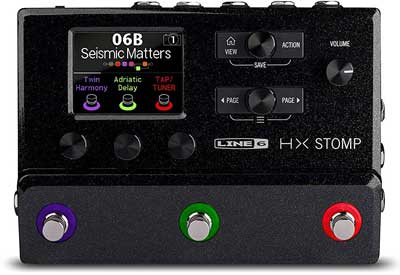
The way you use Impulse Responses with a multi-effects unit is you connect your pedal to your computer, then you’re able to upload the IRs into the pedal. Then you add an IR module to your signal chain.
Impulse Response vs Cabinet Simulator
Cabinet simulators and Impulse Responses both achieve very similar results. Both aim to recreate the sound of a recorded cabinet. Modern cabinet simulators can produce some very impressive results, but you might be surprised with how effective IRs are.
Listen to the below video with a good set of headphones or studio monitors for a great comparison of IRs against cabinet models on the Line 6 Helix:
As you can hear, both the simulation and the IRs produce excellent quality results. They both achieve near identical results, but work in very different ways.
Remember that you can download a massive range of IRs and built up your own custom library. Then you’re able to take those IRs into any loader you want now or in the future and access those same sounds.
Impulse Responses Related Questions
Here are some common questions often asked about Impulse Responses not covered above.
Can Impulse Responses Be Used With Acoustic Guitars?
While IRs are very popular with electric guitarists, they can be used for acoustic guitars as well. The main use of IRs with acoustic guitars is for reverbs. You can use an Impulse Response to add different reverbs to your acoustic guitar for recordings or for live performances.
The other way IRs can be useful for acoustic guitars is when you want to record with a direct out from a Piezo pickup. You can pass the recording through an IR to recreate the sound of recording through a specific type of microphone in a specific type of room.
Can You Create Your Own Impulse Responses?
Yes. Impulse Responses are quite easy to create. If you love the sound of your cabinet but aren’t able to crank your amp all the time to record everything, creating your own Impulse Response is a great idea.
I am working on a guide on how to create your own Impulse Responses and will update this guide when it is available.
Can Impulse Responses Recreate Effects Pedals?
It’s important to remember that Impulse Responses are linear. They cannot reproduce sounds that are dynamic. Most guitar effects pedals are dynamic so IRs cannot properly reproduce them. For example, you hear the sweeping sound of a phaser, the bouncing of a delay pedal, or the pulsing of a chorus pedal.
An easy way to think of IRs is that it’s like taking a snapshot while a guitar pedal is like a movie. Looking at a snapshot of a movie isn’t the same as watching a movie. It’s the same with IRs. An IR can reproduce something linear such as a cabinet and microphone almost perfectly but does a terrible job at reproducing a dynamic effect.
